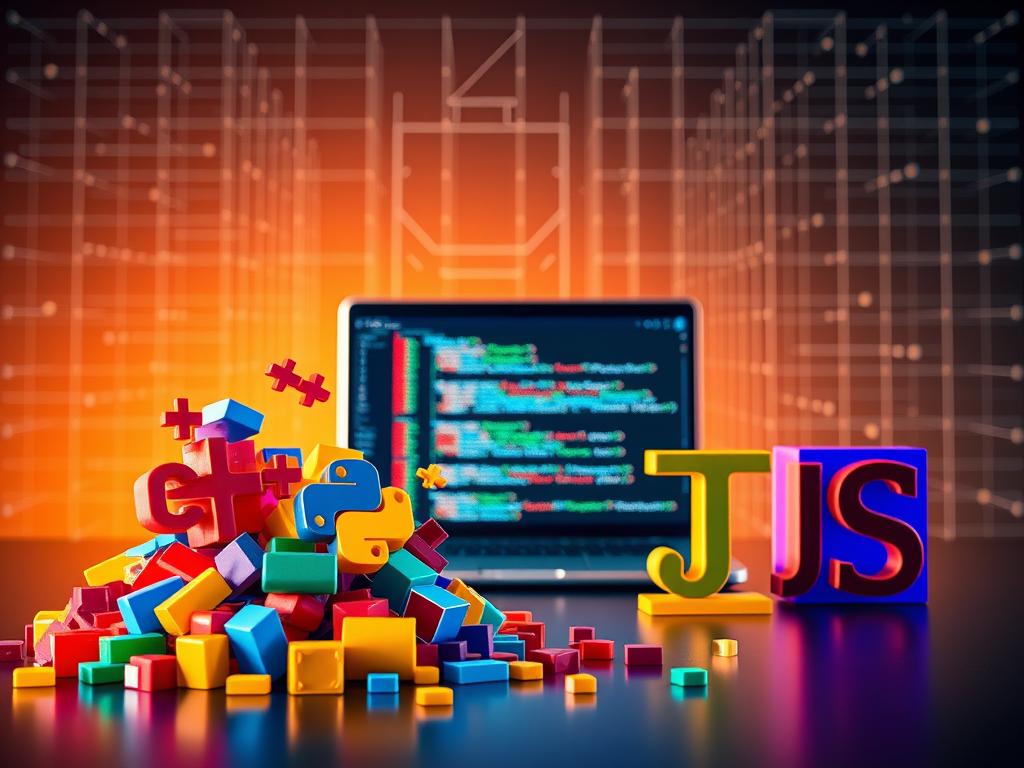Programming languages form the digital backbone of our tech world. They power everything from smartphones to complex industrial systems. Computer science students explore these dynamic coding skills, opening doors to exciting opportunities.
Computer science education provides crucial programming skills across multiple languages. In 2022, programming jobs grew by 23.5%, showing high demand for skilled developers. These languages are vital tools for solving real-world tech challenges.
Python, JavaScript, SQL, and Java are the most sought-after languages in 2023. Each offers unique capabilities and career paths. Python has topped the TIOBE Index since 2022, proving its versatility.
Python excels in engineering, machine learning, and data science. It’s a popular choice for beginners and experts alike. Its wide range of applications makes it a valuable skill to learn.
Computer science students have bright career prospects. Software programmers earn a median annual salary of $120,200. This is much higher than the overall U.S. worker median of $45,000.
Mastering multiple programming languages prepares students for an innovative future. It opens doors to transformative careers in our digital world. Computer science education is a pathway to shaping tomorrow’s technology.
Understanding the Foundation of Computer Science Education
Computer science fundamentals are crucial for modern tech innovation. Students explore a world where programming theory creates powerful digital solutions. The field keeps evolving, offering dynamic paths to understand complex computational systems.
The journey starts with grasping core programming concepts. These are the building blocks of technological innovation. They equip students with critical thinking tools for solving complex computational challenges.
Essential Programming Concepts in Modern Education
- Basic computational logic and algorithms
- Data structures and memory management
- Object-oriented and functional programming paradigms
- Software design principles
Programming Language Learning Pathways
Universities recognise the importance of comprehensive coding education. Recent studies show unanimous agreement on the career benefits of knowing a programming language.
| Programming Language | Popularity in Curricula | Learning Difficulty |
|---|---|---|
| Python | 33% recommended for beginners | Easy |
| Java | 53% taught in colleges | Moderate |
| C++ | 40% used as foundational language | Challenging |
“Programming is not about what you know, but about what you can figure out.” – Chris Pine
The U.S. Bureau of Labor Statistics predicts a 15% increase in computer science jobs. This growth highlights the importance of robust programming theory in education.
Comprehensive coding education is vital for preparing future tech innovators. It equips them with the skills needed to tackle the challenges of tomorrow.
What Programming Languages Do You Learn in Computer Science
Mastering popular programming languages is vital in computer science. Students will explore various languages to tackle complex tech challenges. These tools open doors to exciting career paths.
Computer science education focuses on versatile programming languages. Here are the key languages students often learn:
- Python: Renowned for its readability and beginner-friendly syntax
- JavaScript: The backbone of web development since 1996
- Java: A robust language supporting cross-platform applications
- C++: Critical for systems programming and game development
- SQL: Essential for database management and data analysis
These languages offer unique strengths to the computer science field. They equip students with skills to solve real-world tech problems. Mastering them prepares learners for diverse career opportunities.
| Programming Language | Primary Use | Difficulty Level |
|---|---|---|
| Python | Data Science, Web Development | Beginner-Friendly |
| JavaScript | Web Development | Intermediate |
| Java | Enterprise Applications | Intermediate |
| C++ | Systems Programming | Advanced |
| SQL | Database Management | Beginner to Intermediate |
Learning these languages creates a solid foundation for tech enthusiasts. It paves the way for future innovation in computer science. Students can grow their careers in this ever-changing field.
Industry-Relevant Programming Languages in University Curricula
Universities are adapting their computer science curricula to match industry standards. They focus on languages that offer practical skills for real-world applications. This shift prepares students for dynamic programming careers.
Modern computer science programmes emphasise versatile programming skills. Cutting-edge computer science programmes now take a comprehensive approach to language learning.
- Procedural languages like C++ and Java form the core foundation
- Object-oriented programming languages such as Python develop advanced problem-solving skills
- Scripting languages including Ruby and Bash enhance adaptability
The job market demands diverse programming expertise. Research shows that 75% of computer science graduates value multi-language proficiency. It significantly boosts their employability prospects.
| Language Category | Key Languages | Industry Relevance |
|---|---|---|
| Web Development | JavaScript, HTML, CSS | High demand in digital sectors |
| Cloud Computing | Python, Java, Go | Essential for modern infrastructure |
| Artificial Intelligence | Python, R, Scala | Critical for emerging technologies |
Universities are preparing students for dynamic tech careers through diverse language training. The future favours those who can navigate multiple programming paradigms with ease.
Career Opportunities and Salary Prospects by Programming Language
Programming careers require strategic skill development and understanding of the tech landscape. Software development offers exceptional earning potential across multiple specialisations. The tech sector presents diverse opportunities for professionals with robust programming expertise.
Entry-level software developers can expect starting salaries around £68,000. Experienced professionals with 20+ years can earn up to £100,480 annually. The most lucrative programming careers are in states like California, Washington, and Maryland.
Emerging programming careers show impressive growth projections. Software engineers can expect a 26% job market expansion through 2033. Information security analysts might experience a remarkable 33% growth.
Web developers remain in high demand, with projected job growth of 16% between 2022 and 2032. These statistics highlight the importance of continuous learning in software development careers.
Strategic language specialisation can significantly impact earning potential. Mastering in-demand languages like Python, JavaScript, and Rust often leads to higher-paying positions. The median salary for computer occupations reaches £104,420.
Investing in comprehensive programming skills represents a promising pathway to professional success. It also offers financial stability in the ever-evolving tech industry.








